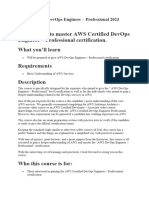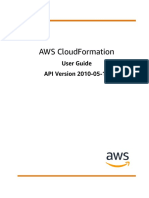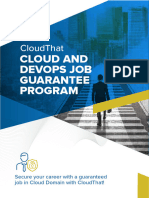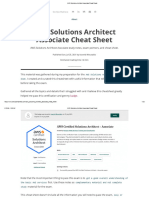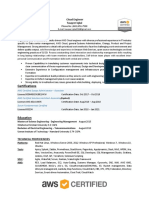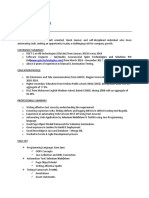DevOps Scenario-Based Interview Guide
Introduction
This document contains scenario-based DevOps interview questions and answers from the perspective of
Dave, a seasoned DevOps engineer with 5 years of experience. The scenarios cover essential DevOps
domains including containerization, CI/CD, cloud architecture, monitoring, security, and more.
Part 1: Containerization and Orchestration
Scenario 1: Docker Image Size Optimization
Question: "Our team is deploying microservices using Docker, but our images are over 1GB each, causing
slow deployments and increased storage costs. How would you approach reducing the image size while
maintaining functionality?"
Answer: "I'd first analyse the current Dockerfile to identify optimization opportunities. I'd implement multi-
stage builds to separate build dependencies from runtime requirements. For example, in a Java application,
I'd use a JDK image for compilation and a JRE-only image for runtime.
I'd also:
Use smaller base images like Alpine Linux (5-10MB) instead of full Ubuntu images (300MB+)
Remove unnecessary packages, temp files, and cache after installation
Consolidate RUN commands to reduce image layers
Implement. dockerignore to prevent unnecessary files from being copied
Consider distroless images for production when appropriate
https://www.linkedin.com/in/saraswathilakshman/
https://saraswathilakshman.medium.com/
�In a recent project, I reduced our Node.js application image from 1.2GB to 120MB by switching to a multi-
stage build with Alpine as the base, properly configuring npm to exclude dev dependencies, and optimizing
our layer caching strategy."
Scenario 2: Kubernetes Pod Scheduling Challenges
Question: "We're running a Kubernetes cluster that's experiencing pod scheduling issues. Some nodes are
overutilized while others remain underutilized. How would you diagnose and solve this problem?"
Answer: "This sounds like a resource allocation and scheduling issue. I'd follow a systematic approach:
First, I'd investigate the current state using:
kubectl describe nodes | grep -e "Name:" -e "Allocated resources"
kubectl top nodes
I'd check for any pod affinity/anti-affinity rules, node selectors, or taints that might be causing uneven
distribution.
To solve this, I'd:
Implement resource requests and limits for all pods to help the scheduler make better decisions
Consider using the Cluster Autoscaler to automatically adjust node count based on pending pods
Apply node labels and pod nodeSelectors for workload-specific nodes
Configure pod disruption budgets for critical services
Potentially use custom scheduling plugins or policies for complex requirements
https://www.linkedin.com/in/saraswathilakshman/
https://saraswathilakshman.medium.com/
�For example, in my previous role, we had a similar issue with database pods clustering on specific nodes. By
implementing topology spread constraints and proper resource definitions, we achieved a 40% more
balanced distribution and reduced node count by 15%."
Scenario 3: Container Security Vulnerabilities
Question: "Our security team has identified several critical vulnerabilities in our containerized applications.
How would you establish a process to detect and remediate container vulnerabilities in our development
and deployment pipeline?"
Answer: "Container security requires a shift-left approach with multiple layers of protection. I'd implement
the following:
Image Scanning Pipeline Integration: Integrate tools like Trivy, Clair, or Aqua Security into our CI/CD pipeline
to automatically scan images
Configure the pipeline to fail builds with critical or high vulnerabilities
Generate reports for developers with remediation steps
Base Image Management: Create and maintain a library of vetted, regularly updated base images
Implement automated base image updates when security patches are available
Use minimal or distroless images where possible
Runtime Protection: Deploy a runtime security solution like Falco or Sysdig to detect anomalous behavior
Implement pod security policies or OPA Gatekeeper to enforce security standards
https://www.linkedin.com/in/saraswathilakshman/
https://saraswathilakshman.medium.com/
�Use network policies to limit container communications
Continuous Monitoring: Implement a container registry scanning schedule for existing images
Create automated alerts for newly discovered vulnerabilities affecting our images
Regular security posture reports and trends
In my previous role, I implemented a similar approach using Trivy and Anc hore in our Jenkins pipeline, which
caught 23 critical vulnerabilities in the first month and reduced our vulnerability remediation time from
weeks to days."
Scenario 4: Service Discovery in Microservices
Question: "We're migrating from a monolithic application to microservices running on Kubernetes. How
would you design a service discovery solution that's reliable, performant, and developer-friendly?"
Answer: "For Kubernetes-based microservices, I'd implement a layered service discovery approach:
Core Service Discovery: Leverage Kubernetes native Service resources as the foundation
Implement consistent naming conventions and labels for all services
Use headless services for stateful applications needing direct pod access
Service Mesh Integration: Deploy Istio or Linkerd to provide advanced traffic management
Implement circuit breaking, retries, and timeout patterns
Use the mesh for advanced observability of service-to-service communication
External Services: Use ExternalName services for third-party dependencies
Implement a service registry like Consul for non-Kubernetes services
https://www.linkedin.com/in/saraswathilakshman/
https://saraswathilakshman.medium.com/
�Create abstractions for external service transitions
Developer Experience:
Generate API documentation automatically using OpenAPI/Swagger
Create development environments with service virtualization
Implement consistent health check endpoints across all services
In a recent project, we used this approach to migrate a 7-year-old monolith to 30+ microservices. We created
a custom Kubernetes operator that automated service registration and DNS configuration, reducing
discovery-related incidents by 85% compared to our initial manual process."
Part 2: Continuous Integration and Deployment (CI/CD)1.
Scenario 5: Pipeline Optimization
Question: "Our CI/CD pipeline for a medium-sized application takes over 45 minutes to complete a
deployment. The dev team is complaining this is slowing their velocity. How would you optimize this pipeline
without compromising quality?"
Answer: "Long pipelines definitely hurt developer productivity. I'd tackle this systematically:
First, I'd profile the pipeline to identify bottlenecks:
jenkins-job-profiler analyse --job=application-deploy --last=10# Or equivalent tool for your CI system
Based on my experience, I'd focus on these optimization areas:
Parallelization: Break the pipeline into parallel execution paths where dependencies allow
Run unit tests across multiple agents/containers
https://www.linkedin.com/in/saraswathilakshman/
https://saraswathilakshman.medium.com/
�Parallelize static code analysis and security scanning
Caching Strategy: Implement effective caching for dependencies (Maven/npm/pip repositories)
Use Docker layer caching to speed up builds
Consider distributed caching solutions like BuildKit
Test Optimization: Implement test pyramids with more unit than integration tests
Use test selection to only run tests affected by changes
Shift non-critical tests to post-deployment verification
Infrastructure Improvements:
Use ephemeral, higher-spec CI runners for resource-intensive tasks
Optimize artifact storage and retrieval
Consider specialized hardware for specific tasks (GPU for ML models)
In my previous role, we reduced a 52-minute pipeline to 13 minutes by implementing these strategies,
particularly by using BuildKit's distributed caching and test selection algorithms, which increased our
deployment frequency by 3x."
https://www.linkedin.com/in/saraswathilakshman/
https://saraswathilakshman.medium.com/
�Scenario 6: Deployment Rollback Strategy
Question: "A critical production deployment has introduced unexpected bugs that weren't caught in testing.
How would you design a rollback strategy, and what measures would you implement to prevent similar
issues in the future?"
Answer: "Fast and reliable rollbacks are essential for production stability. Here's my approach:
For the immediate rollback:
Assess Impact and Communication: Quickly determine the scope and severity of the issue
Notify stakeholders through established communication channels
Consider traffic shaping to minimize user impact
Execute the Rollback: Use immutable infrastructure patterns to restore the previous known-good state
For Kubernetes: kubectl rollout undo deployment/service-name
For infrastructure changes: revert to previous Terraform state
Confirm system health after rollback with automated smoke tests
To prevent future issues:
Pipeline Enhancements: Implement progressive delivery with canary deployments
Add synthetic transaction monitoring before full deployment
Enhance integration test coverage for the specific failure
https://www.linkedin.com/in/saraswathilakshman/
https://saraswathilakshman.medium.com/
�Observability Improvements: Implement business KPI monitoring alongside technical metrics
Create custom dashboards for new feature impacts
Set up anomaly detection for early warning
Process Changes: Conduct a blameless post-mortem to identify root causes
Update the definition of done to include new test scenarios
Consider feature flags for high-risk changes
In a previous role, we improved our rollback time from 15 minutes to under 2 minutes by implementing blue-
green deployments with automated health checks, which reduced our MTTR by 80% and improved our
team's confidence in deployments."
Scenario 7: Deployment Strategy for Zero Downtime
Question: "We have a client-facing application with strict SLAs for availability. What deployment strategy
would you recommend for achieving zero-downtime updates, and how would you implement it?"
Answer: "For zero-downtime deployments, I'd recommend a combination of blue-green deployment with
canary analysis. Here's how I'd implement it:
Infrastructure Setup: Provision duplicate environments (blue and green)
Implement a load balancer or API gateway for traffic control
Set up shared persistent storage or replicated databases
https://www.linkedin.com/in/saraswathilakshman/
https://saraswathilakshman.medium.com/
�Deployment Process:
1. Deploy new version to inactive environment (green)
2. Run automated smoke tests against green environment
3. Route 5% of traffic to green environment (canary)
4. Monitor error rates, latency, and business metrics
5. Gradually increase traffic to 100% if metrics are stable
6. Keep blue environment running for quick rollback
7. After confidence period (24h), update blue environment
Key Technical Components: GitOps workflow using ArgoCD or Flux for environment syncing
Istio or similar service mesh for fine-grained traffic control
Prometheus metrics and automated canary analysis with Flagger
Database Considerations: Implement backward-compatible schema changes
Use techniques like expand/contract pattern for DB migrations
Consider dual-writes for critical data during transition
In my last role, we implemented this strategy for a payment processing system with 99.99% uptime
requirements. By combining blue-green deployments with progressive traffic shifting, we successfully
deployed 3-5 times per day with zero customer-impacting incidents over a 6-month period."
https://www.linkedin.com/in/saraswathilakshman/
https://saraswathilakshman.medium.com/
�Scenario 8: Environment Configuration Management
Question: "Our application needs different configurations across dev, staging, and production
environments. We're experiencing issues where things work in one environment but break in another. How
would you manage environment-specific configurations securely and consistently?"
Answer: "Environment configuration inconsistencies are a common source of the 'works on my machine'
problem. I'd implement a comprehensive configuration management strategy:
Configuration as Code:
Store all configurations in Git alongside application code
Use Kubernetes ConfigMaps and Secrets for config injection
Implement HashiCorp Vault for sensitive credentials
Environment Templating: Use Helm charts with value overrides per environment
Implement Kustomize for Kubernetes resource patching
Create clear inheritance patterns (base → env-specific)
Validation and Testing: Create config schema validation using JSONSchema
Implement config tests as part of the CI pipeline
Use tools like Conftest to enforce policy compliance
Configuration Promotion Strategy:
1. Generate configs from templates during build
https://www.linkedin.com/in/saraswathilakshman/
https://saraswathilakshman.medium.com/
�2. Validate against schema and policy
3. Store generated configs as artifacts
4. Deploy identical artifact across environments
5. Inject environment variables at runtime
Documentation and Visibility:
Create a configuration catalog service
Document the purpose of each config parameter
Implement config drift detection and alerts
In my previous role, we implemented this approach using Helm, Vault, and a custom config validation
service. This reduced environment-related incidents by 70% and cut onboarding time for new services from
days to hours."
Part 3: Infrastructure as Code (IaC)
Scenario 9: Resource Provisioning Automation
Question: "Your company needs to provision identical AWS environments for multiple clients, each with
their own VPC, security groups, databases, and compute resources. How would you approach this using
Infrastructure as Code?"
Answer: "This is a perfect use case for Infrastructure as Code with templating and modularity. Here's my
approach:
Modular Infrastructure Architecture: Develop reusable Terraform modules for each component (VPC, RDS,
EKS, etc.)
https://www.linkedin.com/in/saraswathilakshman/
https://saraswathilakshman.medium.com/
�Implement consistent tagging and naming conventions
Create a hierarchy: base infrastructure → shared services → client-specific
Client Onboarding Automation:
# Example high-level structuremodule "client_vpc"
{ source = "./modules/vpc" client_name = var.client_name cidr_block = var.client_cidr
# More parameters...}
module "client_database"
{ source = "./modules/rds" vpc_id = module.client_vpc.vpc_id
# Security and configuration..
.}
Deployment Pipeline: Implement CI/CD workflow for infrastructure changes
Set up separate Terraform workspaces or state files per client
Create pre-deployment validation with tools like tfsec and checkov
Governance and Compliance: Use AWS Organizations and SCPs for guardrails
Implement automated compliance checks against CIS benchmarks
Create dashboards for resource utilization and cost attribution
https://www.linkedin.com/in/saraswathilakshman/
https://saraswathilakshman.medium.com/
�Operations Considerations: Standardize logging and monitoring across all environments
Create self-service portals for common operations
Implement infrastructure testing with tools like Terratest
In my previous role, we used this approach to manage 45+ client environments with a team of just 3
engineers. We reduced provisioning time from 2 weeks to 2 hours and achieved 100% consistency across all
deployments, significantly improving our security posture and operational efficiency."
Scenario 10: Configuration Drift Management
Question: "You've implemented Infrastructure as Code, but you're noticing that over time, production
environments are drifting from their defined state due to manual changes. How would you detect, prevent,
and remediate configuration drift?"
Answer: "Configuration drift can undermine the benefits of Infrastructure as Code. I'd implement a
comprehensive drift management strategy:
Detection Mechanisms: Schedule regular Terraform plan or AWS Config runs to detect drift
Implement CloudCustodian or custom Lambda functions for continuous checking
Create dashboards to visualize compliance status across resources
Prevention Controls: Implement strict IAM policies that prevent manual console changes
Use resource policies to enforce change through approved pipelines only
Create break-glass procedures for emergency changes with audit trails
https://www.linkedin.com/in/saraswathilakshman/
https://saraswathilakshman.medium.com/
�Automated Remediation: For non-critical drift: automatic terraform apply to restore desired state
For critical resources: alert and approval workflow before remediation
Implement self-healing infrastructure where appropriate
Process Improvements: Require all changes to go through Pull Requests with approvals
Implement infrastructure GitOps with tools like Atlantis
Create emergency change documentation templates
https://www.linkedin.com/in/saraswathilakshman/
https://saraswathilakshman.medium.com/
�In my previous role, we reduced configuration drift incidents by 95% by implementing a combination of
preventive IAM policies and a daily drift detection pipeline that created automatic tickets for the team. This
approach maintained our security posture and reduced audit findings significantly."
Scenario 11: Secret Management in Infrastructure1.
Question: "Our infrastructure code contains sensitive information like database passwords and API keys.
What approach would you recommend for managing secrets securely in an IaC workflow?"
Answer: "Secret management is critical for security and compliance. I'd implement a comprehensive secrets
strategy:
Secret Storage: Deploy HashiCorp Vault as the central secrets management system
Configure AWS KMS for encryption keys management
Implement strict access controls with audit logging
IaC Integration: Use Terraform's vault provider to dynamically fetch secrets
Implement just-in-time credential generation for short-lived secrets
Store secret references, not values, in infrastructure code
https://www.linkedin.com/in/saraswathilakshman/
https://saraswathilakshman.medium.com/
�Secret Rotation: Implement automated secret rotation policies
Use Lambda functions for periodic rotation of credentials
Create hooks to update application configurations post-rotation
Development Workflow: Provide developers with local Vault instances or development tokens
Implement secure CI/CD pipeline with ephemeral secrets access
Create clear documentation for secret request workflows
https://www.linkedin.com/in/saraswathilakshman/
https://saraswathilakshman.medium.com/
�Emergency Access:
Implement break-glass procedures for emergency access
Set up multi-person authorization for sensitive secrets
Ensure comprehensive audit trails for all secret access
In my previous role, we implemented Vault with AWS KMS integration and reduced the risk surface by
eliminating hardcoded secrets from all our repositories. We also automated secret rotation which improved
our compliance posture and reduced manual rotation tasks by 100%."
Scenario 12: Infrastructure Testing Strategy
Question: "How would you test infrastructure code to ensure it's reliable, secure, and performs as expected
before deploying to production?"
Answer: "Testing infrastructure is as important as testing application code. I'd implement a multi-layered
testing strategy:
Static Analysis: Use tools like tfsec, terrascan, and checkov for security scanning
Implement custom linting rules for organization standards
Validate against compliance benchmarks (CIS, HIPAA, SOC2)
Unit Testing: Validate individual modules with Terraform's built-in testing
Use tools like Terratest for module-level validation
Implement property-based testing for complex modules
https://www.linkedin.com/in/saraswathilakshman/
https://saraswathilakshman.medium.com/
�Integration Testing: Deploy to isolated test environments with realistic boundaries
Verify cross-resource dependencies and connections
Test failure scenarios and recovery procedures
Performance Testing: Measure provisioning time and resource creation latency
Test scalability for elastic resources (auto-scaling groups)
Validate API rate limits and service quotas
Security Testing: Run infrastructure penetration tests against test environments
Validate IAM roles and permissions with policy simulators
Test network isolation and security group configurations
Pipeline implementation example
https://www.linkedin.com/in/saraswathilakshman/
https://saraswathilakshman.medium.com/
�In my previous role, we implemented this testing strategy for our AWS infrastructure, which caught 14
critical security misconfigurations before they reached production and reduced our mean time to recovery
by 60% through validated recovery procedures."
https://www.linkedin.com/in/saraswathilakshman/
https://saraswathilakshman.medium.com/
�Part 4: Monitoring and Observability
Scenario 13: Alert Fatigue Mitigation
Question: "Our operations team is experiencing alert fatigue due to a high volume of notifications, many of
which are false positives. How would you redesign the monitoring system to reduce noise while ensuring
critical issues are still caught?"
Answer: "Alert fatigue is a serious operational problem that can lead to missed critical alerts. Here's my
strategy to address it:
Alert Classification and Prioritization: Implement a tiered alert system (P1-P4) based on service impact
Create clear definitions for each severity level
Route alerts to appropriate channels based on urgency
Alert Tuning Process: Analyse 30-day alert history to identify noisy alerts
Implement dynamic thresholds based on historical patterns
Create a regular alert review process (bi-weekly)
Advanced Alert Design: Implement multi-condition alerts to reduce false positives
Use time-based dampening for flapping conditions
Create composite alerts for related symptoms
https://www.linkedin.com/in/saraswathilakshman/
https://saraswathilakshman.medium.com/
�Observability Improvements: Implement SLOs and error budgets to focus on user impact
Create service dependency maps for better context
Deploy distributed tracing for root cause analysis
Cultural Changes: Rotate alert review responsibility among team members
Create "alert-free time" for focused development work
Implement blameless post-mortems for missed alerts
In my previous role, we reduced alert volume by 78% while actually improving incident detection by
implementing these strategies. The key was moving from threshold-based alerts to SLO-based alerts and
implementing proper alert dampening, which dramatically improved the signal-to-noise ratio."
Scenario 14: Slow Application Performance Investigation
https://www.linkedin.com/in/saraswathilakshman/
https://saraswathilakshman.medium.com/
�Question: "Users are reporting that our application is running slowly, but all our basic monitoring shows
green. How would you approach diagnosing and resolving performance issues that aren't showing up in
standard metrics?"
Answer: "Investigating subtle performance issues requires a systematic approach and deeper observability.
Here's how I'd tackle it:
Enhanced Observability Setup:
Implement distributed tracing with OpenTelemetry/Jaeger
Add client-side real user monitoring (RUM)
Deploy synthetic monitoring from multiple regions
Capture detailed database query performance metrics
Systematic Investigation Process:
1. Reproduce the issue using synthetic transactions
2. Analyse end-to-end request traces to identify slow components
3. Correlate slowdowns with system events (deployments, scaling)
4. Check for 'hidden' bottlenecks (DNS resolution, connection pooling)
5. Perform database query analysis6. Isolate third-party service dependencies
Advanced Diagnostics: Profile application in various environments (CPU, memory, I/O)
Implement custom instrumentation for critical paths
Check for network latency and packet loss between services
https://www.linkedin.com/in/saraswathilakshman/
https://saraswathilakshman.medium.com/
�Analyse middleware performance (load balancers, API gateways)
Correlation Analysis: Look for patterns in user reports (time of day, user characteristics)
Check for environmental factors (cloud provider issues, region-specific)
Analyse traffic patterns and potential resource contention
In my previous role, we faced a similar issue where standard metrics showed green but users reported 2-
second delays. Through distributed tracing, we discovered connection pool exhaustion in our Redis layer
that only occurred during specific traffic patterns. By implementing proper connection pooling and
timeouts, we reduced p95 latency by 70% and eliminated user complaints."
Scenario 15: Log Management at Scale
Question: "Our application generates several terabytes of logs daily across multiple microservices. How
would you design a cost-effective log management solution that allows for efficient troubleshooting while
controlling storage costs?"
Answer: "Managing logs at terabyte scale requires balancing observability needs with cost efficiency. Here's
my approach:
Log Tiering Strategy: Implement a multi-tier storage strategy: Hot tier (1-3 days): Fully indexed, high-
performance storage
Warm tier (4-30 days): Partially indexed, compressed storage
Cold tier (31-365+ days): Highly compressed, S3/Glacier storage
Route logs based on criticality and access patterns
https://www.linkedin.com/in/saraswathilakshman/
https://saraswathilakshman.medium.com/
�Log Data Optimization: Implement standardized structured logging across all services
Create sampling policies for high-volume, low-value logs
Use field extraction at ingestion time to optimize indexes
Implement Gzip or Snappy compression for all logs
Technical Implementation:
Service → Fluentd/Vector → Kafka → Elasticsearch (hot) → S3 (warm/cold) → Prometheus metrics
extraction
Cost Control Mechanisms: Create log budget per service with alerting
Implement automatic log level adjustment based on conditions
Run regular log cardinality analysis to identify excessive logging
Use reserved instances or spot instances for log processing
Operational Tooling:
Build centralized dashboards for log volume monitoring
Create pre-configured queries for common troubleshooting
Implement automated log hygiene checks in CI pipeline
Provide self-service log lifecycle management tools
https://www.linkedin.com/in/saraswathilakshman/
https://saraswathilakshman.medium.com/
�In my previous role, we reduced our logging costs by 65% while actually improving troubleshooting
capabilities by implementing tiered storage and intelligent sampling. The key insight was that 80% of our
troubleshooting was done with logs less than 48 hours old, so we optimized our architecture around this
access pattern."
Scenario 16: System Outage Investigation
Question: "You receive an alert at 3 AM that a critical system is down. Walk me through your approach to
diagnosing and resolving the issue, including the tools and methodologies you'd use."
Answer: "Handling middle-of-the-night outages requires a structured approach to minimize MTTR. Here's
my incident response process:
Initial Assessment (0-5 minutes):
Acknowledge the alert and verify it's not a false positive
Check status dashboards for correlated symptoms
Quickly review recent changes (deployments, configuration changes)
Determine customer impact scope using SLO dashboards
First Response Actions (5-15 minutes): If applicable, trigger incident response protocols and alert
stakeholders
Check runbooks for known issues with similar symptoms
Apply immediate mitigation if available (scaling, failover, cache clearing)
Post initial status in incident channel
https://www.linkedin.com/in/saraswathilakshman/
https://saraswathilakshman.medium.com/
�Systematic Investigation (15-30 minutes):
1. Check dependent services and upstream systems
2. Analyse error patterns in logs using structured queries
3. Review tracing data for failed requests
4. Examine resource metrics (CPU, memory, disk, network)
5. Check database performance metrics6. Verify external dependencies (APIs, cloud services)
Tool Arsenal: Centralized logging: Elasticsearch/Kibana, Loki, or CloudWatch
Metrics: Prometheus/Grafana dashboards
Tracing: Jaeger or X-Ray
Infrastructure: AWS Console, Terraform state explorer
Communication: Slack/Teams incident channels
Resolution and Recovery: Implement fix with minimal customer impact
Verify service recovery with synthetic transactions
Update status page and notify stakeholders
Capture key data for post-mortem before evidence is lost
Post-Incident: Document timeline and actions taken
Schedule blameless post-mortem
https://www.linkedin.com/in/saraswathilakshman/
https://saraswathilakshman.medium.com/
�Create tickets for identified improvements
Update runbooks with new findings
In a recent incident, our payment processing service went down at 2 AM due to a certificate expiration.
Despite the hour, we followed this structured approach and resolved the issue in 22 minutes by having
current documentation and implementing a temporary certificate workaround before applying the
permanent fix."
Scenario 17: Custom Monitoring Metrics Design
Question: "Our application has specific business processes that aren't reflected in standard technical
metrics. How would you design custom monitoring that can alert on business-level issues before they impact
users?"
Answer: "Business-level monitoring is essential for detecting issues that may not manifest in traditional
technical metrics. Here's my approach:
Business Metric Identification: Collaborate with product and business teams to identify key metrics:
Conversion rates at each funnel stage
Order submission success rates
Payment processing time
Feature utilization rates
Customer-facing API SLAs
https://www.linkedin.com/in/saraswathilakshman/
https://saraswathilakshman.medium.com/
�Technical Implementation: Instrument application code with custom metrics:
Java
Dashboard and Alerting Design: Create business process dashboards with clear thresholds
Implement multi-stage alerting based on severity:Early warning: Statistical anomaly detection
Warning: Approaching SLO breach
Critical: SLO breach or severe anomaly
Integration with Technical Metrics: Correlate business metrics with technical indicators
Create combined views showing customer journey with system health
Build cross-domain dashboards for incident investigation
https://www.linkedin.com/in/saraswathilakshman/
https://saraswathilakshman.medium.com/
�Continuous Improvement: Implement regular metric reviews with business stakeholders
Adjust thresholds based on seasonal patterns
Use A/B testing data to refine normal baseline values
Example implementation for an e-commerce platform:
Key Metrics:- Cart abandonment rate (real-time)- Payment gateway response time (p95)- Order fulfilment
success rate (per warehouse)- Product search relevance score (user satisfaction)- Account creation
completion rate
In my previous role, we implemented business metrics monitoring for a financial services platform. This
approach detected a subtle issue in our account verification flow that wouldn't have triggered technical
alerts but was causing a 15% drop in conversions. By alerting on the business metric, we resolved the issue
before it significantly impacted revenue."
Part 5: Cloud Services and Architecture
Scenario 18: Cloud Migration Strategy
Question: "Your company wants to migrate a legacy on-premises application to AWS. The application
consists of a Java backend, Oracle database, and relies on local file storage. How would you approach
planning and executing this migration?"
Answer: "Cloud migrations require careful planning and a phased approach. Here's how I'd handle this
specific migration:
Assessment and Discovery: Document current architecture and dependencies
Identify integration points with other systems
Profile database usage patterns and resource requirements
https://www.linkedin.com/in/saraswathilakshman/
https://saraswathilakshman.medium.com/
�Map out current security and compliance requirements
Estimate current costs for TCO comparison
Migration Strategy Selection: For this specific stack, I'd recommend a combined approach:
Database: AWS DMS for Oracle to Aurora PostgreSQL migration
Application: Containerize Java app for ECS/EKS deployment
Storage: Migrate from local files to S3 with CloudFront CDN
Consider AWS App2Container for initial containerization
Technical Design:
Migration Execution Plan: Create detailed runbooks for each migration component
Set up data replication for minimal downtime (AWS DMS)
Implement CI/CD pipeline for the containerized application
Establish VPN or Direct Connect for hybrid phase
Deploy Cloud Foundation (networking, security, IAM)
Testing and Validation: Create performance baseline for comparison
Implement comprehensive pre and post-migration testing
Perform security assessment of cloud environment
Run parallel operations during transition
https://www.linkedin.com/in/saraswathilakshman/
https://saraswathilakshman.medium.com/
�Operational Readiness: Update monitoring and alerting for AWS environment
Create cloud-specific runbooks and disaster recovery plans
Train operations team on AWS services and tools
Implement cloud cost management and optimization.
https://www.linkedin.com/in/saraswathilakshman/
https://saraswathilakshman.medium.com/












